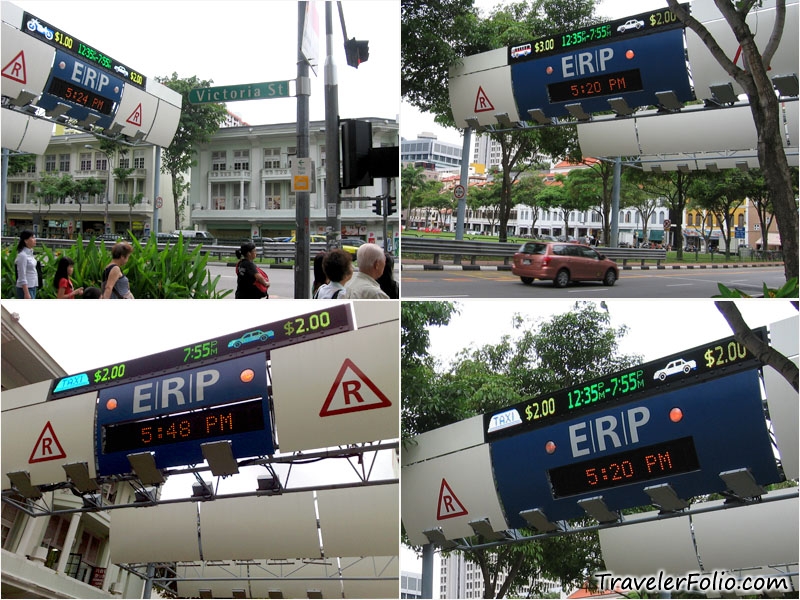
Background
In 1998, the manual congestion pricing systems that had been operating in Singapore since 1975 were replaced by an electronic road pricing system. ERP gantries replaced the overhead gantries at each entry point.
It started off with 29 ERP points at the entry points to an enclosed area of 720 ha in the city called the Restricted Zone (RZ) and 12 ERP points along congested stretches of expressways and major roads. Initially, ERP for RZ operated from 7.30am-7.00pm on weekdays and ERP on the other roads operated during the morning peak hour period of 7.30am-9.30am on weekdays.
In 2011, the RZ has 28 entry points, plus an additional 12 points within it. The times of operation has remained the same with some additional charging on Saturdays and some late evenings. Outside the RZ, on the expressways and major arterials, there are 30 ERP points. Times of operation are generally during the morning and evening peak periods with some extending into the late evenings and Saturday. On Sundays, Public Holidays and the eve of 5 major festivals, the ERP does not operate.
Aim of ERP
The aim of ERP is to charge vehicles for the use of the road at times and at places when and where they cause congestion. Vehicles pay an ERP fee each time that they go under an ERP gantry.
The ERP is a congestion management measure and collection of revenue is incidental. The revenue goes into a common revenue pool. The ERP revenue is not earmarked for expenditure on transportation infrastructure and operations
The System
The ERP system started working as a short-range radio communication system (DSRC) using a 2.40 GHz band. Later on, some minor changes were made to the band to move it away from the effects of Bluetooth devices. It is a multi-lane free flow (MLFF) system, with no barrier, no centre divider and consisting of 2 gantries per control point.
The main components are:
The In-vehicle Unit (IU)
This is a note-book sized device fixed permanently at the lower right hand corner of the windscreen of vehicles (the driver’s seat is on the right). It gets its electric power from the vehicle battery. On motorcycles and scooters, the IU is on the handlebar. In 1998, 98% of the vehicle population of 700,000 has fitted the IU, although it is not compulsory. Nowadays all new vehicles come fitted with an IU. There are different colour-coded IUs for different classes of vehicles because the ERP fees are different. Only emergency vehicles (ambulances, fire engines and marked police cars) are exempt from ERP and even they have their own IUs, because vehicles without IUs will be photographed by the cameras. These special IUs do not have to use a CashCard. Non-motorised traffic does not pay ERP fees. There is a 5 year warranty on the IU.
In 2009, the second generation of dual mode IUs which are smaller in size have been issued which can also accept contactless CashCards (Contactless E-Payment Application Standard (CEPAS) compliant cards), in addition to contact cards.
Currently, there is also a Motorpay system, whereby ERP charges can be paid via registering to deduct from credit cards. There is no need for driver to insert the Cashcard into his IU, if he has subscribed to the Motorpay.
CashCard
The CashCard is the mode of payment for ERP. A consortium of local banks looks after the sale and distribution of CashCard, which is a prepaid contact integrated circuit chip plastic card. It is a contact card. It can be topped up with money at automatic teller machines up to a value of S$500. The consortium keeps the cash float from the sale of the cards and settles the account with the Land Transport Authority (ERP operator) at the end of each working day. The CashCard can also be used for buying petrol, groceries and for paying car parking charges. There are about 7 million contact cashcards in use. Lately, the contactless Cashcards have appeared on the scene, which are also used on public transport.
ERP overhead gantries (or outstations) located at the control points
A control point has two sets of overhead gantries at a height of 6m and set apart at 15 m. The equipments on the gantries are antennae for communicating with the IU of vehicles, optical sensors to detect passing vehicles and enforcement cameras to take photographs of the rear license plates of violating vehicles. Data from the outstation is sent back to the control centre through dedicated telephone lines by the local controller.
Control centre
The control centre receives the records of all ERP transactions, fault records of and digital photographs of violating vehicles from all the outstations. The control centre does the cash settlement with the CashCard operators, sends out summons demanding fines from violating drivers and invites drivers of vehicles experiencing errors to send their vehicles for free inspection. It also sends violation report of foreign vehicles to the outgoing checkpoints at the border as soon as such violations are recorded
Working of ERP
As the vehicle nears the first of the two ERP gantries at the outstation, the antenna the IU, determines its validity, classifies it (car, motorcycle, bus etc) and instructs it to deduct the appropriate ERP fee. Between the two gantries, the IU deducts the appropriate ERP fee from the stored value of the CashCard and confirms that it has done so to the antenna at the second ERP gantry. The enforcement camera takes a digital photograph of the rear licence plate of the vehicle with violations or errors, recording the reason for the photograph. The local controller at the outstation sends back the ERP fee deduction data and digital photographs to the control centre at regular intervals
0 comments:
Post a Comment